Pencader is a small village situated about two miles south-east of Llandysul and five miles south-west of Llanybydder. The village was originally formed around the site of a castle, but the village really thrived during the glory years of the Great Western Railway, when it became a halt on the Carmarthen to Aberystwyth line. The men of Pencader who fell during both World Wars are commemorated on a fine war memorial which sits beside the former railway station. At first sight the memorial looks an easy one to research, as it contains the dates of death of the men. However, several of these dates are incorrect and also several of the men commemorated are not official casualties of war and are not commemorated by the CWGC.

The Great War, 1914-1918
Thomas Ansell, Private, 14340, Welsh Regiment. Thomas was the son of John and Hannah Ansell, of Cnwcdu, Pencader. He enlisted at Carmarthen into the 1/4th Battalion, Welsh Regiment, which was formed during August 1914 in Carmarthen. The Battalion was attached to 159 Brigade, 53rd (Welsh) Division, and in July 1915 sailed from Devonport for Egypt. On 9 August 1915 the Division had moved from Egypt, and landed on Gallipoli. They fought on Gallipoli until evacuation in December 1915, after suffering terrible casualties, and moved to positions on the Suez Canal. In early 1917 the British were fighting in Mesopotamia, before moving into Palestine to fight the Turks, and Thomas was killed in action in Mesopotamia on 25 January 1917. He was just 19 years old, and is remembered on the Basra Memorial, Iraq. Thomas is not commemorated on the Pencader memorial.
Benjamin Davies, Corporal, A/413, Kings Royal Rifle Corps. Benjamin was the son of Ben and Rachel Davies, of Neaudd Deg, Llanpumsaint. He resided at Cwmgreiciaufach, and worked as a Haulier. Benjamin had enlisted at London on 12 August 1914 into the 7th Battalion, King’s Royal Rifle Corps. The battalion was attached to 41 Brigade, 14th (Light) Division, and landed at Boulogne on 19 May 1915. The Division moved into positions east of Ypres, and became the first British unit to be attacked by German flamethrowers during the German assault at Hooge on 30 July 1915. The 7th KRRC were positioned on the south side of the newly blown Hooge Crater, when at 3.15 p.m. jets of fire shot across from the German trenches towards their positions, and then a German Artillery Barrage saturated the ground. Vicious hand to hand fighting ensued, but the Germans didn’t follow up their attack, and the line stabilised again. Benjamin survived this horrific attack, but was wounded by gunfire on 5 October 1915 and evacuated to England for treatment. He died of wounds at the Queen’s Canadian Military Hospital, Shorncliffe on 15 October 1915, aged 23. Benjamin is buried in Llanpumsaint (Saer Calem) Baptist Chapelyard. The Pencader War Memorial incorrectly shows his date of death as 20 October 1915.


Evan Henry Davies, Private, 1753, Welsh Guards. Evan was the son of Evan and Mary Davies, of Emlyn Villa, Pencader. He served in the 1st Battalion, Welsh Guards, which had moved to France in August 1915 attached to 3 Brigade, Guards Division. The Division had a distinguished career during the Great War, fighting at the Battle of Loos, and through the Somme Offensive at the Battles of Flers-Courcelette and Morval. In 1917 they followed the German retreat to the Hindenburg Line, and then fought later that year at Third Ypres, at the Battles of Pilckem, the Menin Road, Poelcapelle and Passchendaele, and saw the year out fighting at the Battle of Cambrai. In 1918 they were near Gouzeaucourt when the area was hit by the German Spring Offensive of 21 March 1918. The Guards, as indeed were all of the British Divisions in the area, were pushed back beyond Bapaume towards Albert, where the German Offensive stagnated. The war turned during the month of August 1918 after a brilliant Australian success at Villers Brettoneux on 8 August 1918 was followed by a successful British breakthrough on the old Somme Battlefields on 21 August, when the Battle of Albert saw the Germans pushed back beyond Bapaume in a few terrible days fighting. Evan was wounded around this time, and brought back to the Base Hospital at Rouen, where he sadly died of wounds on 22 September 1918, aged 22. He is buried at St. Sever Cemetery Extension, Rouen, France.


John Cynfyn Davies, Private, 55432, Royal Welsh Fusiliers. John was the son of the Reverend William Jones Davies and Margaret Agnes Davies (nee Morgan), of Blaenblodau Hall, Pencader. He enlisted at Lampeter into the 16th Battalion, Royal Welsh Fusiliers, which was attached to 113 Brigade, 38th (Welsh) Division. The Brigade landed at Havre during December 1915, and moved to positions near Armentieres. They fought through some of the hardest and most famous battles of the Great War-at Mametz Wood during the Battle of the Somme, and at the Pilckem Ridge during the battle of Passchendaele. During March 1918, the 15th RWF was in reserve at The Laundry, Erquinghem. On 6 March 1918 they relieved the 13th Welsh in support trenches at Houplines. Eight men were wounded by gas on 9 March, and for the next few days the area was continually shelled and gassed by the Germans. After suffering badly here the Division was rushed south to assist with the desperate defence of Albert. The German Spring Offensive had swept across the old Somme Battlefields, and had pushed the Allies back further than ever. However, the attack burnt itself out, and for several months this resulted in a stalemate settling along the line on the Somme. John was killed in action near Albert during the attack on Bouzincourt Ridge on 22 April 1918. He was 25 years old, and is remembered on the Pozieres Memorial, France. John is not commemorated on the Pencader memorial.

Titus Davies, Private, 11258, Welsh Regiment. Titus was the son of Thomas and Elizabeth Davies of Glantalog, Pencader. He enlisted at Cardiff into the 8th Battalion, Welsh Regiment, which was attached to 40 Brigade, 13th (Western) Division. The division embarked at Avonmouth on 29 June 1915, and landed at Gallipoli on 6 July 1915, and were immediately thrown into battle. Titus was killed in action just two days after landing, on 8 August 1915. He was just 20 years old, and is remembered on the Helles Memorial, Gallipoli. The Pencader War Memorial incorrectly shows his date of death to have been 7 August, which is excusable considering the chaos which followed the Gallipoli landings.
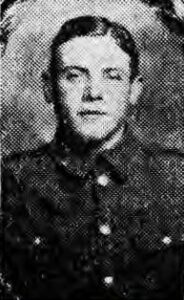
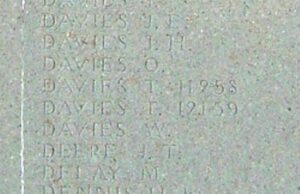
Tom Davies, Private, 436795, Canadian Infantry. Tom was born on 29 April 1884, the son of James and Hannah Davies, of Brynamlwg, Pencader. He emigrated to Canada prior to the war, where he worked as a Miner, and he enlisted there at Edmonton on 8 February 1915. Tom was posted to the 49th Battalion (Edmonton) Canadian Infantry, which were attached to 7 Canadian Brigade, 3rd Canadian Division, which formed in France during December 1915. The Division moved to positions around Ypres. On 12 April 1916 the battalion was in the front line near Hooge when they were attacked by a German raiding party. The attack was beaten off, but the Germans retaliated with heavy artillery fire on the Canadian trenches. Tom was killed in the ensuing bombardment that day. He was 32 years old, and is buried at Menin Road South Military Cemetery, Belgium.

Evan Holmes, Private, 885, Australian Infantry. Evan was born on 27 June 1897, the son of Josiah and Mary Holmes, of Bryntwely, Pencader. The family emigrated to Australia, where they lived at Bungalow, Cairns, Queensland. Evan enlisted at Cairns on 12 March 1915 into the 25th Battalion, Australian Infantry, which was attached to 7 Brigade, 2nd Australian Division, and he landed on Gallipoli with his Battalion just months later. Evan was shot in the head on 13 October 1915 and brought to a Field Ambulance, where he died soon after that same day. He was just 18 years old, and is buried at 7th Field Ambulance Cemetery, Gallipoli. His brother George Henry also died. Neither brother is commemorated locally.
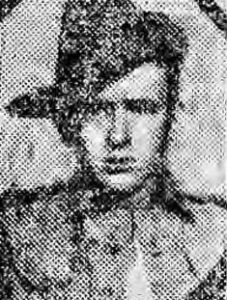

George Henry Holmes, Private, 2899A, Australian Infantry. George was born on 19 January 1896, the son of Josiah and Mary Holmes, of Bryntwely, Pencader. The family emigrated to Australia prior to the war, where they resided at Bungalow, Cairns, Queensland, and George enlisted at Cairns on 20 June 1916, just eight months after his brother Evan was killed in Gallipoli. George was posted to the 52nd Battalion, which was attached to 13 Brigade, 4th Australian Division, and he embarked at Brisbane on 27 October 1916 bound for England. After a spell in hospital ill, he was posted to the Western Front on 25 June 1917, where he joined his Battalion in the line. The 4th Australian Division were by now posted in Ypres, and were ready to take part in the Battles of Third Ypres, or Passchendaele. George was killed in action during the Battle of Passchendaele on 18 October 1917. He was 21 years old, and is buried at Passchendaele New British Cemetery, Belgium. Neither brother is commemorated locally.

Daniel James, Private, 200168, Welsh Regiment. Daniel was born on 7 February 1888, the son of Thomas and Mary James, of Lan Farm, Pencader. He worked as a coalminer at Tumble prior to enlisting at Carmarthen into the 1/4th Battalion, Welsh Regiment. The Battalion was attached to 159 Brigade, 53rd (Welsh) Division, and in July 1915 sailed from Devonport for Egypt. On 9 August 1915 the Division had moved from Egypt, and landed on Gallipoli. They fought on Gallipoli until evacuation in December, 1915, after suffering terrible casualties, and moved to positions on the Suez Canal. In early 1917 the British launched an attack into Palestine, which was occupied by the Turks, and Daniel was killed in action here at the First Battle of Gaza, on 21 April 1917, aged 29. He was originally buried in Sampson’s Ridge, No. 1 Cemetery, but his grave was re-interred after the war and he now lies in Gaza War Cemetery.


David Griffiths James, Private, 39510, South Wales Borderers. David was the son of Thomas and Rachel James, of 8, Davies Street, Pencader. He worked as a Butcher, and enlisted at Port Talbot into the Monmouth Regiment. He subsequently transferred into the 2nd Battalion, South Wales Borderers. The battalion had had a novel start to the war. It had defeated the German Garrison at Tientsin, China, before taking place in the Gallipoli Landings on 25 April 1915, attached to 87 Brigade, 29th Division. They remained here until evacuation to Egypt on 11 January 1916 and then moved to the Western Front on 15 March, which is when David joined the battalion. The Division took part in its first major action in France during the 1916 Somme Offensive, which is where David was killed in action, aged 19, on 21 October 1916 during the Battle of the Ancre. David’s body was lost in the terrible conditions on the battlefield, and so he is remembered on the Thiepval Memorial, France.


John James, Private, 54561, Welsh Regiment. John was born in Pencader and was the husband of Lillian James. He enlisted at Llanelli into Pembroke Yeomanry and was posted to France during the summer of 1917, joining the 14th Battalion, Welsh Regiment, which was attached to 114 Brigade, 38th (Welsh) Division. The Division was by then at Ypres after having taken part in heavy fighting at Mametz Wood. Their next major offensive was at the Battle of Pilckem, and then the Battle of Langemarck, where John was wounded. He Died of Wounds at the Casualty Clearing Station at Dozinghem on 13 September 1917, and is buried at Dozinghem Military Cemetery, Belgium. John is not commemorated on the Pencader Memorial.
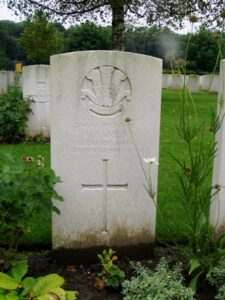
Evan Jenkins, Private, 260465, Gloucestershire Regiment. Evan was born in Pencader, the son of Griffith and Mary Jenkins. The family had moved to Gregynog House, New Road, Pwll, Llanelly prior to the war. Evan enlisted at Llanelli into the South Wales Borderers, and subsequently transferred into the 12th Battalion, Gloucester Regiment, which was attached to 95 Brigade, 5th Division. The Battalion had originally landed in France on 21 November 1915 and had moved to the sector around St. Laurent Blangy over the winter of 1916/1917. In July, 1916 the Division moved south, and fought throughout the Somme Offensive, at the Battles of High Wood, Guillemont, Flers-Courcelette, Morval and Le Transloy, and on 5 November were moved from the line, and posted to Festubert to rebuild. In Spring, 1917 the Division fought during the Arras Offensive, during the Battles of the Vimy and the Scarpe, and after another rest period were moved north, where they fought at Third Ypres, at the Battles of Polygon Wood, Broodseinde, Poelcappelle and Passchendaele. Evan was wounded during the Battle of Passchendaele, and was brought to the Base Hospital at Wimereux for treatment. He sadly died of wounds here on 2 November 1917 aged 29, and is buried in Wimereux Communal Cemetery, France. Evan is not commemorated at Pencader.

John Jenkins, Private, 38937, Welsh Regiment. John was the son of John and Mary Ann Jenkins, of Nantllech, Pencader. He enlisted at Carmarthen into the 2nd Battalion, Welsh Regiment, which had landed in France in August, 1914 as part of 3 Brigade, 1st Division. The Division fought at the Battle of Mons, and took part in the epic retreat to the Marne, where the German Advance was stopped in its tracks. They then followed the withdrawing Germans to the Aisne, and fought another pitched battle here, before being moved to positions east of Ypres. They famously halted the German attack towards Ypres, but at heavy cost, during First Ypres, and spent their first winter in Flanders. In 1915 the Division fought at the Battle of Aubers Ridge, and then at the Battle of Loos. They remained around Loos throughout the winter of 1915/1916 and were due to move to the Somme in June 1916. John was wounded by a shell before the move, and died of wounds two days later, on 9 June 1916, aged just 19. He is buried at Noeux-Les-Mines Communal Cemetery, France.

David Jones, Private, 56380, Welsh Regiment. David was born in Pencader, the son of David and Sarah Jones. The family later resided at 6, Margam Terrace, Port Talbot, Glamorgan. David enlisted at Cardiff into the 9th Battalion, Welsh Regiment, which were attached to 58 Brigade, 19th (Western) Division. The Division moved to France during July 1915 and had seen its first action at the Battle of Loos. In July 1916 they formed the second wave of the attack along the Albert to Bapaume Road, and captured La Boiselle, and fought throughout the Somme Offensive for the rest of 1916. In the summer of 1917 the Division fought at the Battle of Messines, and then at the Battle of the Menin Road, Polygon Wood, Broodseinde, Poelcapelle and at Passchendaele Village. At the beginning of 1918 the Division had been moved to the area north of St. Quentin, and were hit there by the German Spring Offensive of 21 March 1918 where the Division was hit hard during the resulting Battle of St. Quentin and the Battle of Bapaume, and were relieved and moved to positions near Messines to rebuild and rest. Unluckily for them though, the Germans switched the focus of their attack to Flanders, and David was wounded at the Battle of Messines. He died of wounds on 16 April 1918, aged just 18 years old, and is buried at Haringhe (Bandaghem) Military Cemetery, Belgium. David is not commemorated at Pencader.
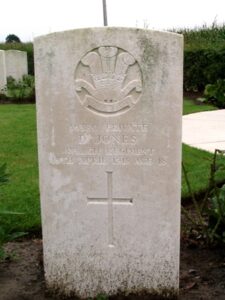
Johnnie Jones, Sapper, 215010, Royal Engineers. Johnnie was born on 3 September 1890, the son of David and Elizabeth Jones, of Cader Vale, Pencader. He worked as a railway clerk at Pencader prior to enlisting into the Royal Engineers on 14 February 1916. He embarked for France on 6 September 1918 and served overseas until 19 March 1919 when he sailed back to England. Johnnie was discharged from the army as physically unfit on 17 April 1919 and returned home to Pencader, where he died of tuberculosis on 14 October 1920, aged 30. His case has recently been forwarded to the CWGC and is awaiting adjudication.
John Jones, Private, TR/4/12333, Welsh Regiment. John was born in 1888, the son of Mary Jones, of Cartref, New Inn, Pencader. He enlisted on 9 December 1915 at Newcastle Emlyn into the 20th Battalion, Welsh Regiment, part of the 13th Reserve Brigade. The Battalion became part of the Training Reserve in 1916, severing its ties with the Welsh. John became ill while training, and died of tuberculosis at Kinmel Park on 27 February 1917, aged 28, without having seen overseas service. He is buried at Llanllwni (St. Luke) Churchyard. The memorial is again incorrect, showing his date of death as 3 March 1917.
Thomas Lloyd Rees Jones, Lieutenant, South Wales Borderers. Thomas was born in Pencader, the son of Thomas Rees Jones and Mary Jones. Thomas was commissioned from Lampeter College, into the 4th Battalion, South Wales Borderers. Thomas saw service with the battalion in Mesopotamia, but became ill, and returned home. He was then posted to Ireland, where the rebellion was gaining pace. In February 1918 he married Charlotte Mary Davies, of 7, Guildhall Square, Carmarthen, and after the armistice, went to Germany with the Army of Occupation. Thomas suffered a re-occurrence of malaria while in Germany, and returned home, but complications set in, and Thomas died on 29 September 1919. He was 26 years old and is buried in Llanfihangel-Ar-Arth (St. Michael) Churchyard. The Pencader War Memorial incorrectly gives his date of death as 21 September 1919.


Edward Last, Private, 4825, Pembroke Yeomanry. Edward was the son of Robert and Ellen Last of Woolwich, London. Prior to the war he had moved to Pencader with his brother William, and both men worked for Thomas and Phoebe Picton at Pant-To, Pencader. Edward had served with the 2/1st Battalion, Pembroke Yeomanry, which was the Reserve (Home Service) Battalion. He was then attached to the Labour Corps. Edward died at Bedford on 15 November 1918, aged 29 and is buried in Kempston Cemetery, Woolwich.

Henry James Lewis, Private, Royal Army Service Corps. Harry was the son of David and Mary Lewis, of Aeron Villa, Pencader. He served during the war with the Army Service Corps. Little else is known of Harry, but he died on 3 October 1921, aged 22. Harry is not commemorated by the CWGC, and so little else is presently known of him. His brother, Lewis Lewis, served as a Shoeing Smith with the Army Service Corps and survived the war.
Daniel Rees, Private, 12581, Devonshire Regiment. Daniel was the son of John and Sarah Rees, of 3, Lewis Street, Pontwelly, Llandyssul. He enlisted at Ferndale into the 9th Battalion, Devonshire Regiment, which was attached to 20 Brigade, 7th Division, and moved to Belgium on 6 October 1914, landing at Zeebrugge. Due to the imminent collapse of the Zeebrugge defences, the Division were moved south, and took up positions east of Ypres. Here, they fought the advancing German Army to a standstill during First Ypres, and settled down for their first winter on the Western Front. In March, 1915 they fought at the Battle of Neuve Chappelle, and then in May fought at Aubers Ridge. They then fought at Givenchy, before taking part in the Battle of Loos in September. After a hard winter near Loos, they moved to the Somme in June, 1916, and fought during the Somme Offensive, at the Battles of Albert and Bazentin. They then moved towards Delville Wood, where Daniel was killed in action on 4 September 1916. He was 22 years old, and is buried at Delville Wood Cemetery, Longueval, France. The Pencader War Memorial incorrectly shows his date of death as 3 September.

David Griffith Thomas, Private, 492712, London Regiment. David was born at Llanfihangel-ar-Arth, and moved to London prior to the war, with his wife Elizabeth Thomas. David enlisted at Finsbury into the 5th Battalion, London Regiment. David subsequently transferred into the 2/13th Battalion (Kensington), London Regiment, which was attached to 179 Brigade, 60th Division. After a short period in Ireland, helping to quash the rebellion, the Division moved back to England, and then to France on 22 June 1916. In November 1916 they moved to Salonika, where they fought in the Battle of Doiran, and remained there until moving to Palestine on 2 July 1917. Here they fought in the Third Battle of Gaza, the Capture of Beersheba and the Capture of the Sheria Position, and went on to fight at and capture Jerusalem in December 1917. David was wounded during the Battle of Jerusalem, and died of wounds on 28 December 1917, aged 30. He is buried at Jerusalem War Cemetery, Israel.
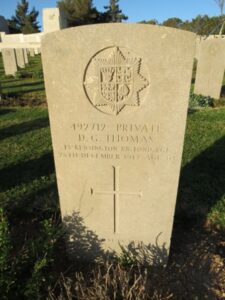
James Thomas, Gunner, 218777, Royal Garrison Artillery. James was the son of Henry and Elizabeth Thomas, of Lan Meredith, Brechfa. James enlisted at Carmarthen on 21 May 1918 into the Royal Garrison Artillery, and was posted to their No. 1 Depot, to undergo training. James died of pneumonia in Magdalen Camp Hospital at Winchester on 28 June 1918, aged just 19, and is buried at Gwernogle Congregational Burial Ground.
Thomas Thomas, Gunner, 171623, Royal Garrison Artillery. Thomas was the son of John and Anne Thomas, of Ysgubor, Pencader. He was residing in Burry Port prior to the war, and enlisted at Llanelli into the Royal Garrison Artillery, being posted to the Western Front with their 158th Siege Battery. Thomas was wounded during the latter stages of the Third Battle of Ypres, and died of wounds on 10 December 1917. He was 24 years old, and is buried at Dozinghem Military Cemetery.


William Thomas, Sapper, WR/317268, Royal Engineers. William was born at Panteg Shop, Llanllwni, the son of William and Mary Thomas and was the husband of Elizabeth Thomas, later of Cross Inn Fach, Llanfihangel-ar-arth. He was a Packer with the GWR at Swansea prior to joining the enlisting into the Royal Engineers. He had already been serving for two years when he joined the 263rd Railway Company, RE, which was raised at Longmoor and embarked to France on 26 April 1917. Once in France, William was assigned to a construction train, and his unit were deployed in laying new standard gauge track, often in very close proximity to the front. William took ill, and died in France of influenza on 19 November 1918, aged 25. He is buried at Awoingt British Cemetery, France.


World War Two, 1939-1945
Islwyn Alban, Gunner, 1138909, Royal Artillery. Islwyn was the son of Thomas and Mary Alban, of 5, Waterloo Street, Llanelli. His parents moved back to their native Llanybydder at sometime before the war, and Islwyn married Elizabeth Jones, of Coedmor, Pencader, in 1942. Islwyn served with the 65th Field Regiment, Royal Artillery, which had been in France in 1939 as part of the 44th Division of the BEF. The remnants of the 65th Field Regiment were among the thousands of British and French soldiers that were pulled off the beaches of Dunkirk during May and June, 1940. They were then sent to North Africa, and fought at the Battles of Alam Halfa and El Alamein, and were disbanded in North Africa after El Alamein. The 65th Field Regiment, RA went on to serve in Italy, during the Landings at Anzio, and Islwyn was killed in action during the Battle of Anzio on 22 May 1944, during the Allied breakout of the Beach-Head. He was 29 years old, and he is buried in Beach Head War Cemetery, Anzio.
David Ionawr Davies, Marine, PLY/X101160, Royal Marines. David was the son of Thomas and Elizabeth Davies, of Aberbele, Pencader. He served with the 11th Battalion, Royal Marines, and he landed with them at Tobruk during Operation Daffodil. The Operation was part of Operation Agreement, which was intended to drive the Italian forces out of Tobruk, but it failed dismally, costing three ships and several hundred soldiers and Royal Marines. David was killed in action at Tobruk on the second day of the operation, on 14 September 1942. He was 31 years old, and is buried in Tobruk War Cemetery.
Thomas William Davies, Aircraftman 2nd Class, 2203359, Royal Air Force Volunteer Reserve. Thomas was the son of Henry and Jane Davies, of Withington, Manchester, and served as an Aircraftman at No. 21 AFU, based at RAF Tatenhill. He was killed whilst flying in Airspeed Oxford II, Serial X7278, which crashed near Adderley in Shropshire on 20 July 1944. He was 19 years old and is buried in Llanfihangel-Ar-Arth (Pencader) Cemetery. Thomas is not commemorated on the Pencader Memorial.
Arthur Selwyn (Dewi) Jones, Driver, 70689, Royal Army Service Corps. Arthur was the Husband of Martha Jane Jones, of Swansea. The War Memorial gives him as being from Typoeth, Pencader, and his name as Dewi, but this is the only man who fits the date. Arthur served with the Royal Army Service Corps, and was in North Africa after the outbreak of war, and was caught up in the Siege of Tobruk.Tobruk was an important Harbour, and was captured by the Allies on 22 January 1941. In the meantime, Rommel had landed with his Afrika Korps, and began to drive the Allies back across North Africa. This left the vital Harbour of Tobruk isolated, and so began the epic siege. Arthur was killed in action on 15 April 1942 in Tobruk. He was 38 years old, and is buried in Tobruk War Cemetery.
Clifford Raymond Jones, Gunner, 986733, Royal Horse Artillery. Clifford was the son of Daniel and Sarah Jane Jones, of Cottage Farm, New Inn. Clifford served with the 107th (The South Notts. Hussars) Regiment, Royal Horse Artillery. The South Notts Hussars were attached to the 5th Cavalry Brigade at the start of war. In 1940 the Brigade moved from France to Palestine, and fought in Wavell’s Offensive against the Italians. At one stage, over 5,248 Italians surrendered to one gun from the South Notts. Hussars. They then moved to Tobruk, where they gained much esteem for their part in the Defence of Tobruk, along with the 9th Australian Division, and after the break out from Tobruk, they joined the 22nd Armoured Brigade. They then fought in the Battle of Knightsbridge, which lasted from 27 May to 6 June 1942, and were ordered to stand and fight until the last man. Clifford was killed in action here on 27 May 1942 aged just 21, and is remembered on the Alamein Memorial.
Pencader War Memorial Unveiling Ceremony
